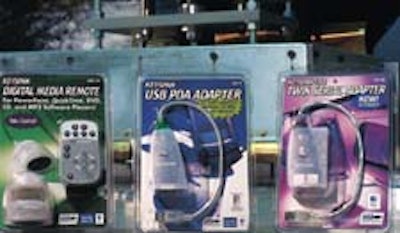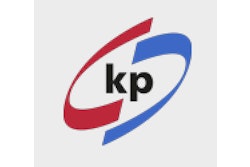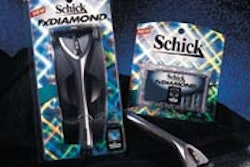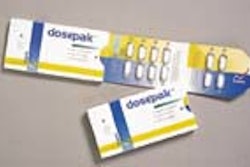The trend toward clear see-through packaging is driven by one fundamental marketing truth: Consumers want to see what they’re buying—even when the product is a practical, technical one like Keyspan adapters for personal computers.
Responding to feedback from retailers, Keyspan changed in early 1999 from a corrugated box, which it had used for six months, to a clear, one-piece hinged plastic blister package. Keyspan used this new package to introduce its newest product, the universal serial bus personal digital assistant (USB PDA) adapter. It’s used to connect Palm organizers and other PDAs to the USB port on a Mac or PC and for other products already on the market.
Mike Ridenhour, president of Richmond, CA-based Keyspan, states that “the previous packaging did not allow a customer to see the enclosed product. There was a photo of the product on the outside, but it was not as appealing or effective as showing the product itself.”
The new package uses Klöckner Pentaplast of America’s (Gordonsville, VA) 20-mil clear Pentaform® TH 557 rigid vinyl. It’s thermoformed by Merrill’s Packaging (Burlingame, CA), which also packs out the products for Keyspan.
Ridenhour states that “Although the specific shape of the package was made for our product(s), other companies can certainly make and use packaging that is essentially the same as ours.” Keyspan sells its products worldwide, and response from retailers to the new package is enthusiastic. Ridenhour notes that strong sales in retail stores, such as Micro Center and Datavision, indicate that customers appreciate the package as well. Between the savings in actual package production and reduced packing time because of the clamshell design, Ridenhour calculates that the new package costs 20¢ less than the previous one.
A division of Innosys Inc., Keyspan originally started selling other adapters through mail-order outlets in 1997, using a shrink-wrapped corrugated box and four-color custom-printed sleeve. According to Ridenhour, the new PDA Adapter was never sold in a corrugated box. Keyspan had sold a different USB adapter in a corrugated box.
“When we first showed retail store buyers the products, they told us that the box would not be as effective on store shelves as another type of package that made the product more visible,” says Ridenhour. Not only was the product not visible in the box, but the graphic on the sleeve was a conceptual illustration, showing little men moving data from one place to another—not a realistic rendering of the product itself.
Rapid response, quality design
Merrill’s was recommended to Keyspan by the company designing the enclosure (containing the circuitry and wires) of the adapter products themselves. Merrill’s experience in thermoforming, as well as rapid response and quality design, were key factors in Keyspan’s selection.
“We made the decision to change the packaging fairly late in the process of rolling out the new product. Merrill’s was very responsive, coming back to us quickly with samples and a proposal after we gave them some guidance on the general package characteristics we were looking for,” Ridenhour explains.
Merrill’s proposed a clear rectangular clamshell formed around the product with a four-color, printed glossy, coated paper insert for text. The back of the new package has a thermoformed cavity that serves two purposes: it allows the package to stand on the store shelf, and for some products, it holds the cable part of the adapter. The clamshell also has a hang tab so that it can be displayed on a rack. While different Keyspan products require different shapes to be thermoformed into the sheet, all the new packages are the same size: 61/8”x 9½”. This durable package protects the product during shipping and in the retail environment where customers are constantly handling the adapters, notes Merrill’s Brian Meltzner. The USB PDA retails for $39.
Keyspan was pleased with the package concept, but wanted retailers to see it before finalizing the design. In 1999, it took a sample to Fry’s Electronics, a West Coast store chain that provided Keyspan with enough feedback to proceed with the next test of the package.
The next step was to display the pack at RetailVision, a show where computer product manufacturers make several 20-minute presentations to a room of potential buyers specializing in their particular type of product. In April 1999, Keyspan focused its three sessions on presenting the change in packaging, showing both the older box and the new clamshell. “We got unanimous feedback from buyers that the new clamshell package would be more successful in the stores,” notes Ridenhour.
Thermoforming the package
Merrill’s state-of-the-art facility uses microprocessor-controlled thermoformers to make Keyspan’s clamshell package. Temperature settings and other parameters are downloaded into the thermoformer from a “recipe” or program created for the particular package. Klöckner’s vinyl film is pulled by pin chains through the thermoformer, where it is heated until it becomes pliable. It then enters a modular, aluminum tool that creates the shape of the package. Meltzer notes that “All the tools we use are made of machined aluminum. We built this tool as a modular tool so we’d have the flexibility to remove and add different configurations during the manufacturing process.”
Pressure forming and plug assists are used to make the one-piece hinged blister pack. After each package is inspected, it’s nested with other packs inside a corrugated shipping case, 20 units/case, and shipped to Custom Assembly & Packaging (Richmond, VA) for assembly and packing.
Keyspan uses Custom Assembly because it respects and wants to support the contract packer’s mission to provide business and production opportunities for the developmentally disabled in Northern California.
While packing the clamshell is faster and easier than setting up and packing boxes, going into the retail store arena with a clamshell required the extra step of radio-frequency welding for tamper-evidence and product security. The products are manually assembled and packed into the clamshells together with a descriptive card and installation CD. Then four sets of three completed packages are put on the turntable of a system from High Frequency Technology (Deer Park, NY). An upper die system produces RF seals around the rim of the clamshells.
Notes Ridenhour, “We didn’t do this to cut costs, but saving money makes it better. We’re very pleased with the new package and have received many favorable comments from retailers since making the change.”



























